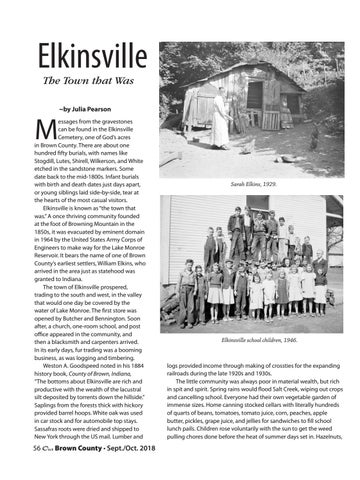Elkinsville The Town that Was
M
~by Julia Pearson
essages from the gravestones can be found in the Elkinsville Cemetery, one of God’s acres in Brown County. There are about one hundred fifty burials, with names like Stogdill, Lutes, Shirell, Wilkerson, and White etched in the sandstone markers. Some date back to the mid-1800s. Infant burials with birth and death dates just days apart, or young siblings laid side-by-side, tear at the hearts of the most casual visitors. Elkinsville is known as “the town that was.” A once thriving community founded at the foot of Browning Mountain in the 1850s, it was evacuated by eminent domain in 1964 by the United States Army Corps of Engineers to make way for the Lake Monroe Reservoir. It bears the name of one of Brown County’s earliest settlers, William Elkins, who arrived in the area just as statehood was granted to Indiana. The town of Elkinsville prospered, trading to the south and west, in the valley that would one day be covered by the water of Lake Monroe. The first store was opened by Butcher and Bennington. Soon after, a church, one-room school, and post office appeared in the community, and then a blacksmith and carpenters arrived. In its early days, fur trading was a booming business, as was logging and timbering. Weston A. Goodspeed noted in his 1884 history book, County of Brown, Indiana, “The bottoms about Elkinsville are rich and productive with the wealth of the lacustral silt deposited by torrents down the hillside.” Saplings from the forests thick with hickory provided barrel hoops. White oak was used in car stock and for automobile top stays. Sassafras roots were dried and shipped to New York through the US mail. Lumber and
56 Our Brown County • Sept./Oct. 2018
Sarah Elkins, 1929.
Elkinsville school children, 1946.
logs provided income through making of crossties for the expanding railroads during the late 1920s and 1930s. The little community was always poor in material wealth, but rich in spit and spirit. Spring rains would flood Salt Creek, wiping out crops and cancelling school. Everyone had their own vegetable garden of immense sizes. Home canning stocked cellars with literally hundreds of quarts of beans, tomatoes, tomato juice, corn, peaches, apple butter, pickles, grape juice, and jellies for sandwiches to fill school lunch pails. Children rose voluntarily with the sun to get the weed pulling chores done before the heat of summer days set in. Hazelnuts,



